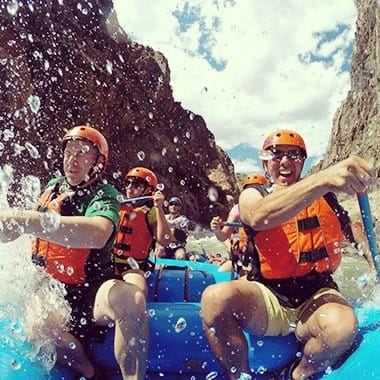Bringing together a group of people and exploring new outdoor adventures can be one of the most beneficial activities a team of people can do for each other. Regardless of what type of group you are actively participating in or working with, exploring new ways to have fun is something that’s highly underestimated. Group white water rafting trips are some of the most popular activities these days, as they encompass the idea that everyone that’s going will have to work together in order to achieve a goal, while also having a lot of fun. 
Reasons for Group White Water Rafting Trips
- Overcoming the Odds
Everyone going will have to make sure that they’ve prepared for the group rafting trip, both mentally and physically. Preparing for a trip like this will take a little courage from some people, especially those that have concerns with being in moving water. Fortunately, river rafting is an activity that is conducted with the utmost regard for safety and professionalism by all respectable outfitters. Group rafting trips also present an opportunity for people to overcome their hesitations with being in moving water and do so with a group of people they know they can trust, and feel somewhat comfortable around. Another positive to choosing a group rafting trip as a team building activity is that rafting outfitters routinely have a variety of trips to choose from. So if your group is not the most physically fit or is a little intimidated by the idea of a high adventure raft trip, you can choose a calmer float-style trip that will give everyone a taste of adventure while keeping everyone closer to their comfort zone.
- A Change of Pace
From the moment that you enter the outfitter’s place of business and see the rafts and gear loaded on trailers, along with the friendly guides and staff welcoming you, you’ll forget the world you’ve temporarily left behind. A sudden jolt of excitement and anticipation will occur the second you and your group get instructed to grab your gear and hop on the bus. With the thought of a new adventure on the horizon, a bus full of people can become instantaneously energetic. For people that have a lot of monotonous actions in their lives, a group rafting trip adventure becomes a major change of pace. This promotes a sense of change and ultimately the enhancement of people’s souls. And this new adventure is often enjoyed the most by those guests who were the most timid coming into the experience. It usually takes just one or two rapids to boost the confidence of that once-timid rafter before they are craving the next big wave and excitedly joining in the ‘paddle high five’ after the crew celebrates another successful run through a rapid.
- Team Building Exercise
Even though each group will have a guide to instruct them on how to conduct themselves within the raft and especially during rapids, every person within their rafting group will have a responsibility to work together in order to achieve all of the micro challenges that group rafting trips entail. Since rafting guides will be very instructive and demanding of people’s attention, everyone within the group will have to stay focused and listen to all of the commands given. Whether it is “left forward one” or “right backward twice,” the commands will need to be met on cue in order for the raft to be directed on the right course through the rapid.

- An Experience for Everyone to Remember
The most significant benefit of participating in group rafting trips is that it provides an adventure that everyone can remember and talk about whenever there is a time for conversation. Since there will be opportunities on the river for everyone to have a shining moment, group rafting trips provide future moments of levity for the group to converse about. There’s nothing better than giving your fellow group members a little bit of a tough time about the way that they reacted during a huge splash or a hard hit into a river hydraulic. A team building raft trip isn’t all about the rapids though; professional guides are often very knowledgeable about the local geology, plants, and animals. Guides are excellent story tellers as well, but don’t be too surprised if they throw in a good natured tall tale just for fun to see who they can get to buy it!
- The Opportunity for Conflicts to be Resolved
Whether it’s an ongoing feud between a couple of boys in a Boy Scout troop or a couple of employees in the workplace, group rafting trips can present an opportunity for underlying tensions to be neutralized through group interactions and potential bonding moments. Something as subtle as a work conflict can dwell within a few employees for years, causing ongoing tensions that can actually be detrimental to the work atmosphere and productivity. A shared group rafting trip unravels those tensions, puts everyone on the same level, and allows for a focus on an activity where the priority is fun and adventure – ideas we can all agree on.
Planning a team building activity like this, “where the objectives are clearly stated and can be met,” will promote good feelings, healthy interactions, and reasonable expectations.
Author:

Ben Sack is the General Manager of Echo Canyon River Expeditions, Colorado’s largest white water rafting outfitter. He’s also a raft guide, photographer and a father of two boys. He writes to inspire the adventurer in all of us to get out and explore our rivers. (Google+, Facebook, Twitter, Linkedin)